TOYOTA AURIS HYBRID 2014 Owners Manual
Manufacturer: TOYOTA, Model Year: 2014, Model line: AURIS HYBRID, Model: TOYOTA AURIS HYBRID 2014Pages: 788, PDF Size: 21.16 MB
Page 241 of 788
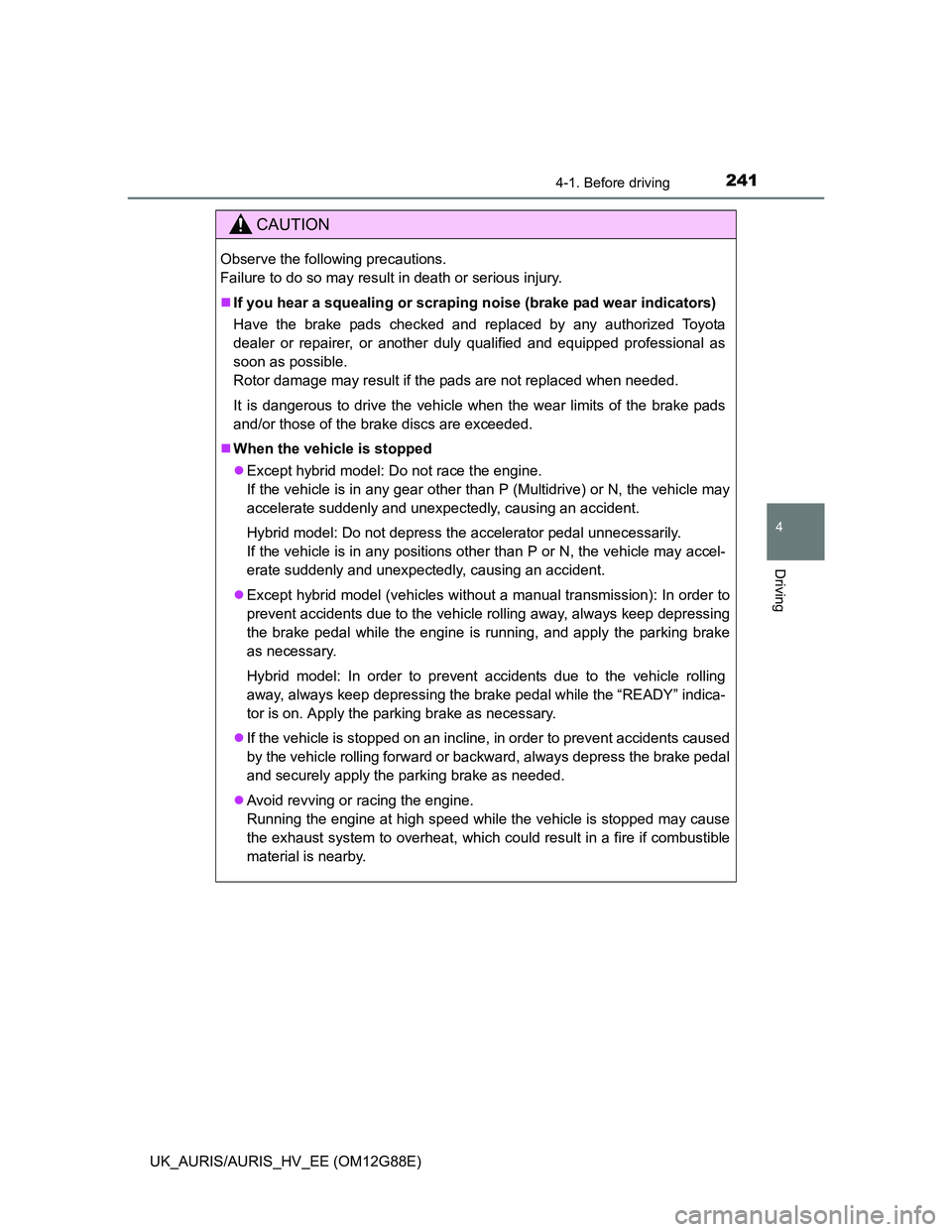
2414-1. Before driving
UK_AURIS/AURIS_HV_EE (OM12G88E)
4
Driving
CAUTION
Observe the following precautions.
Failure to do so may result in death or serious injury.
If you hear a squealing or scraping noise (brake pad wear indicators)
Have the brake pads checked and replaced by any authorized Toyota
dealer or repairer, or another duly qualified and equipped professional as
soon as possible.
Rotor damage may result if the pads are not replaced when needed.
It is dangerous to drive the vehicle when the wear limits of the brake pads
and/or those of the brake discs are exceeded.
When the vehicle is stopped
Except hybrid model: Do not race the engine.
If the vehicle is in any gear other than P (Multidrive) or N, the vehicle may
accelerate suddenly and unexpectedly, causing an accident.
Hybrid model: Do not depress the accelerator pedal unnecessarily.
If the vehicle is in any positions other than P or N, the vehicle may accel-
erate suddenly and unexpectedly, causing an accident.
Except hybrid model (vehicles without a manual transmission): In order to
prevent accidents due to the vehicle rolling away, always keep depressing
the brake pedal while the engine is running, and apply the parking brake
as necessary.
Hybrid model: In order to prevent accidents due to the vehicle rolling
away, always keep depressing the brake pedal while the “READY” indica-
tor is on. Apply the parking brake as necessary.
If the vehicle is stopped on an incline, in order to prevent accidents caused
by the vehicle rolling forward or backward, always depress the brake pedal
and securely apply the parking brake as needed.
Avoid revving or racing the engine.
Running the engine at high speed while the vehicle is stopped may cause
the exhaust system to overheat, which could result in a fire if combustible
material is nearby.
Page 242 of 788
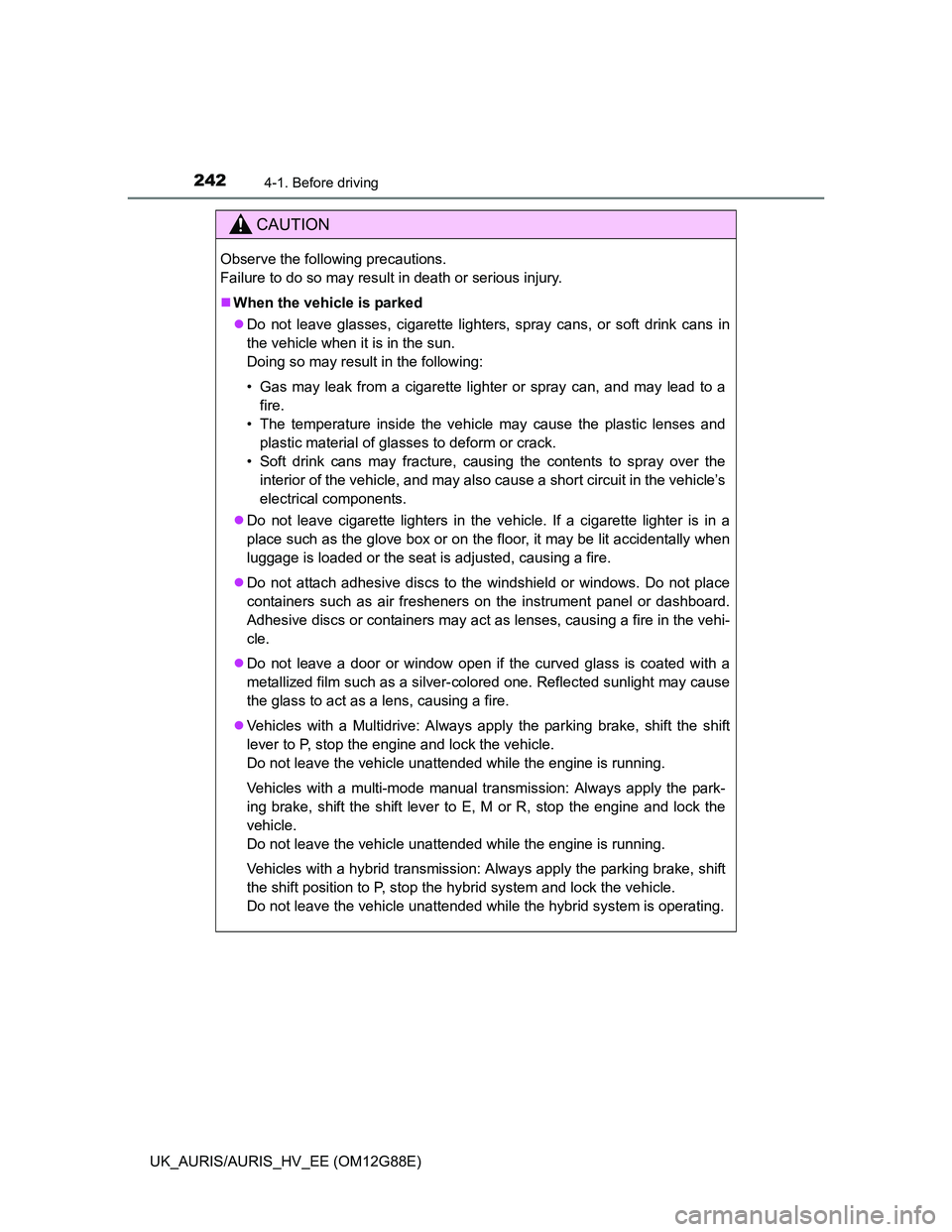
2424-1. Before driving
UK_AURIS/AURIS_HV_EE (OM12G88E)
CAUTION
Observe the following precautions.
Failure to do so may result in death or serious injury.
When the vehicle is parked
Do not leave glasses, cigarette lighters, spray cans, or soft drink cans in
the vehicle when it is in the sun.
Doing so may result in the following:
• Gas may leak from a cigarette lighter or spray can, and may lead to a
fire.
• The temperature inside the vehicle may cause the plastic lenses and
plastic material of glasses to deform or crack.
• Soft drink cans may fracture, causing the contents to spray over the
interior of the vehicle, and may also cause a short circuit in the vehicle’s
electrical components.
Do not leave cigarette lighters in the vehicle. If a cigarette lighter is in a
place such as the glove box or on the floor, it may be lit accidentally when
luggage is loaded or the seat is adjusted, causing a fire.
Do not attach adhesive discs to the windshield or windows. Do not place
containers such as air fresheners on the instrument panel or dashboard.
Adhesive discs or containers may act as lenses, causing a fire in the vehi-
cle.
Do not leave a door or window open if the curved glass is coated with a
metallized film such as a silver-colored one. Reflected sunlight may cause
the glass to act as a lens, causing a fire.
Vehicles with a Multidrive: Always apply the parking brake, shift the shift
lever to P, stop the engine and lock the vehicle.
Do not leave the vehicle unattended while the engine is running.
Vehicles with a multi-mode manual transmission: Always apply the park-
ing brake, shift the shift lever to E, M or R, stop the engine and lock the
vehicle.
Do not leave the vehicle unattended while the engine is running.
Vehicles with a hybrid transmission: Always apply the parking brake, shift
the shift position to P, stop the hybrid system and lock the vehicle.
Do not leave the vehicle unattended while the hybrid system is operating.
Page 243 of 788
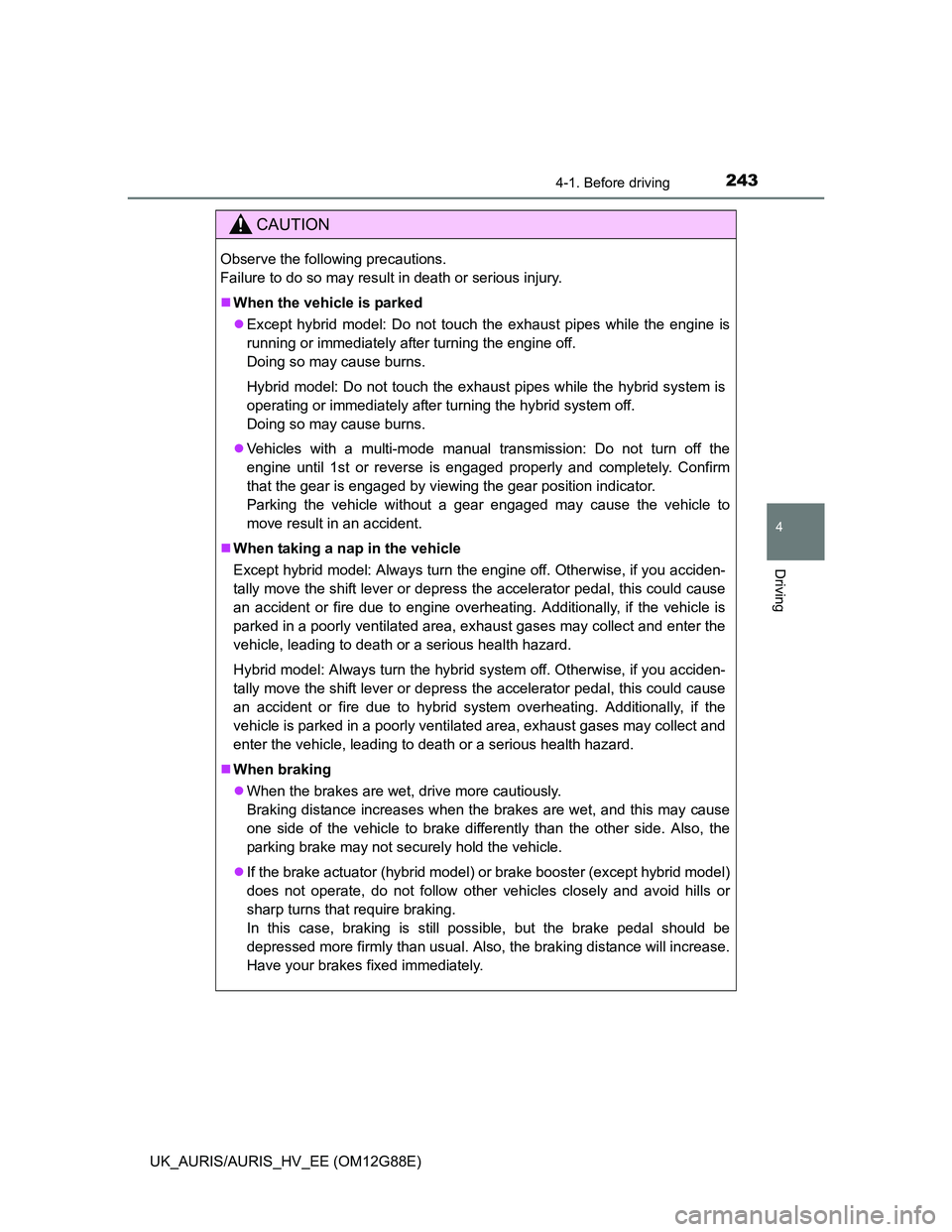
2434-1. Before driving
UK_AURIS/AURIS_HV_EE (OM12G88E)
4
Driving
CAUTION
Observe the following precautions.
Failure to do so may result in death or serious injury.
When the vehicle is parked
Except hybrid model: Do not touch the exhaust pipes while the engine is
running or immediately after turning the engine off.
Doing so may cause burns.
Hybrid model: Do not touch the exhaust pipes while the hybrid system is
operating or immediately after turning the hybrid system off.
Doing so may cause burns.
Vehicles with a multi-mode manual transmission: Do not turn off the
engine until 1st or reverse is engaged properly and completely. Confirm
that the gear is engaged by viewing the gear position indicator.
Parking the vehicle without a gear engaged may cause the vehicle to
move result in an accident.
When taking a nap in the vehicle
Except hybrid model: Always turn the engine off. Otherwise, if you acciden-
tally move the shift lever or depress the accelerator pedal, this could cause
an accident or fire due to engine overheating. Additionally, if the vehicle is
parked in a poorly ventilated area, exhaust gases may collect and enter the
vehicle, leading to death or a serious health hazard.
Hybrid model: Always turn the hybrid system off. Otherwise, if you acciden-
tally move the shift lever or depress the accelerator pedal, this could cause
an accident or fire due to hybrid system overheating. Additionally, if the
vehicle is parked in a poorly ventilated area, exhaust gases may collect and
enter the vehicle, leading to death or a serious health hazard.
When braking
When the brakes are wet, drive more cautiously.
Braking distance increases when the brakes are wet, and this may cause
one side of the vehicle to brake differently than the other side. Also, the
parking brake may not securely hold the vehicle.
If the brake actuator (hybrid model) or brake booster (except hybrid model)
does not operate, do not follow other vehicles closely and avoid hills or
sharp turns that require braking.
In this case, braking is still possible, but the brake pedal should be
depressed more firmly than usual. Also, the braking distance will increase.
Have your brakes fixed immediately.
Page 244 of 788
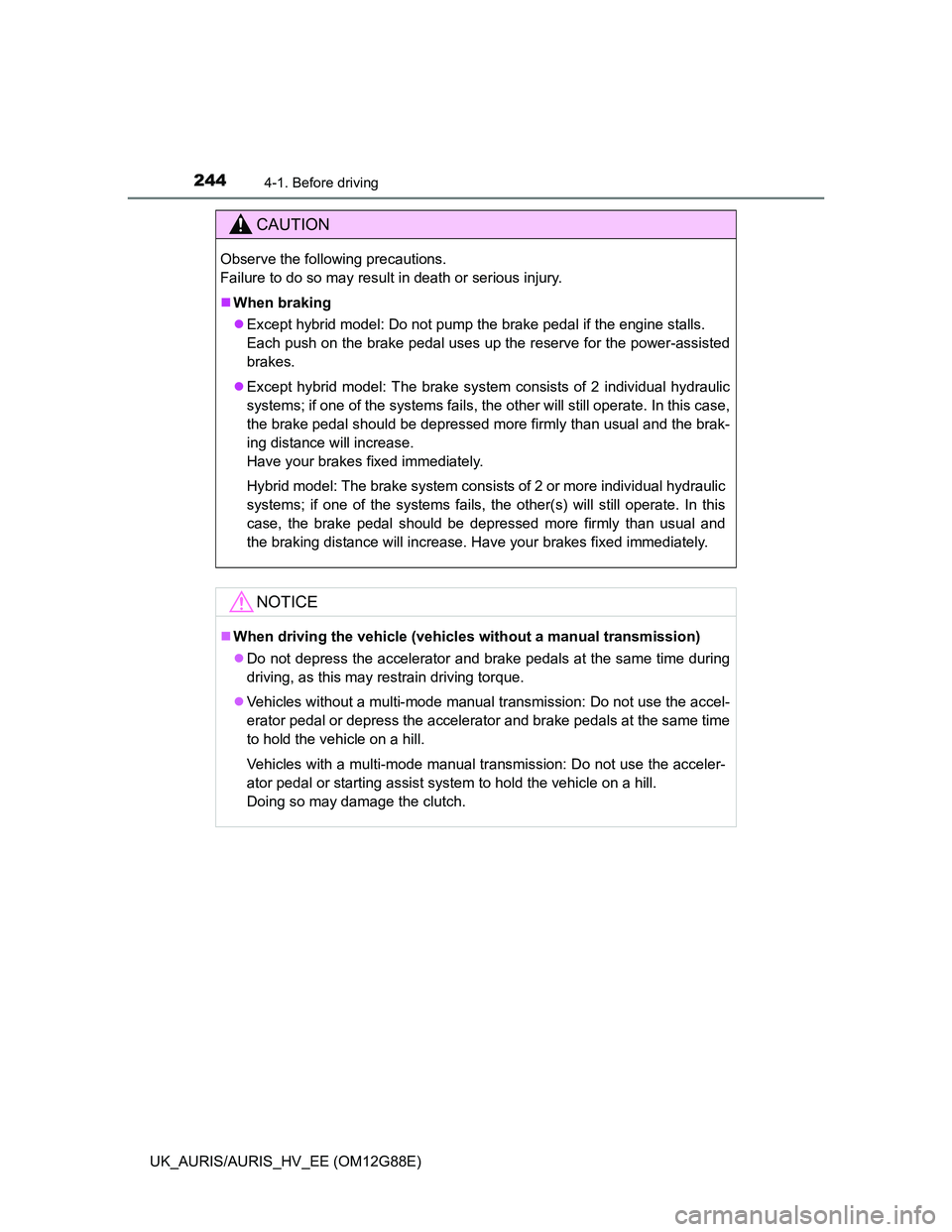
2444-1. Before driving
UK_AURIS/AURIS_HV_EE (OM12G88E)
CAUTION
Observe the following precautions.
Failure to do so may result in death or serious injury.
When braking
Except hybrid model: Do not pump the brake pedal if the engine stalls.
Each push on the brake pedal uses up the reserve for the power-assisted
brakes.
Except hybrid model: The brake system consists of 2 individual hydraulic
systems; if one of the systems fails, the other will still operate. In this case,
the brake pedal should be depressed more firmly than usual and the brak-
ing distance will increase.
Have your brakes fixed immediately.
Hybrid model: The brake system consists of 2 or more individual hydraulic
systems; if one of the systems fails, the other(s) will still operate. In this
case, the brake pedal should be depressed more firmly than usual and
the braking distance will increase. Have your brakes fixed immediately.
NOTICE
When driving the vehicle (vehicles without a manual transmission)
Do not depress the accelerator and brake pedals at the same time during
driving, as this may restrain driving torque.
Vehicles without a multi-mode manual transmission: Do not use the accel-
erator pedal or depress the accelerator and brake pedals at the same time
to hold the vehicle on a hill.
Vehicles with a multi-mode manual transmission: Do not use the acceler-
ator pedal or starting assist system to hold the vehicle on a hill.
Doing so may damage the clutch.
Page 245 of 788
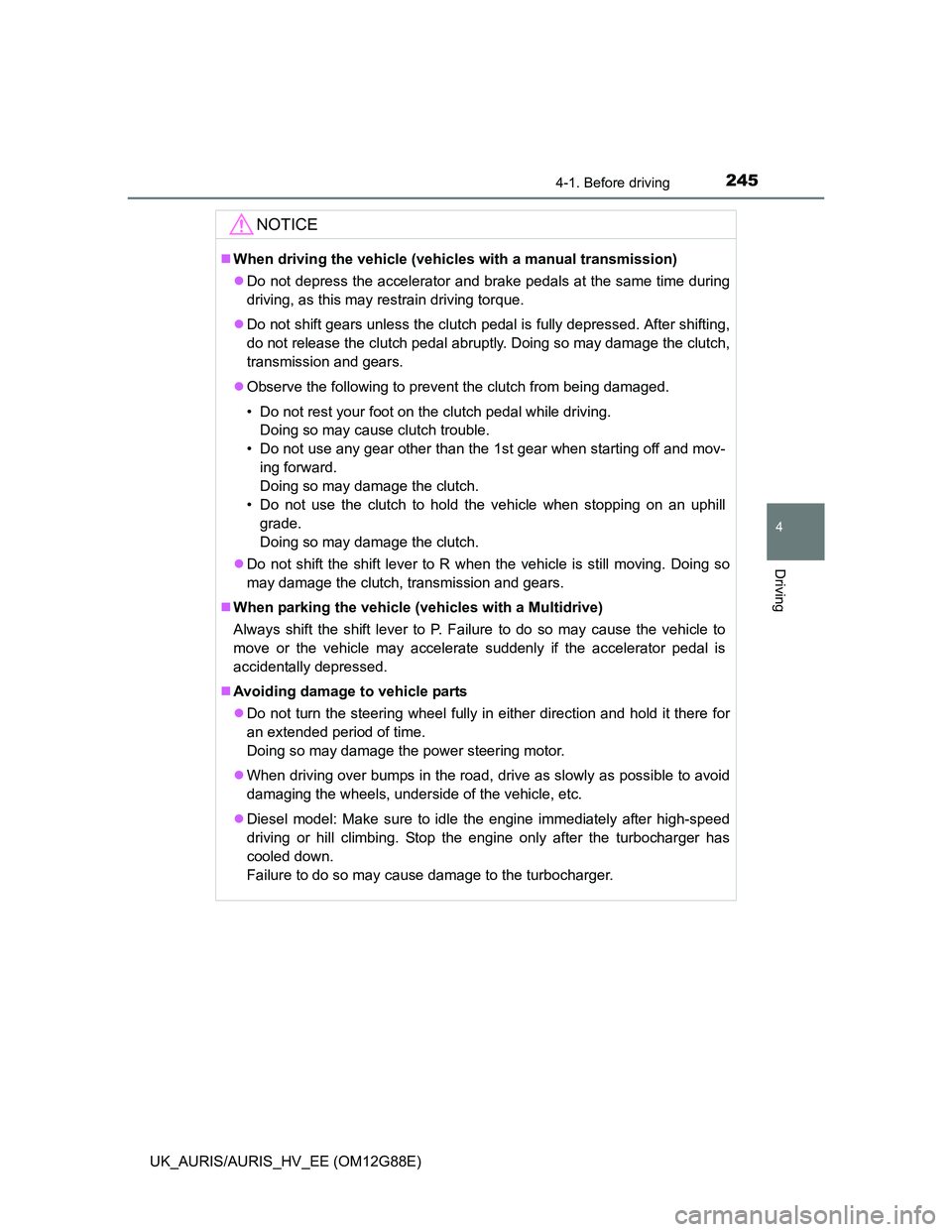
2454-1. Before driving
UK_AURIS/AURIS_HV_EE (OM12G88E)
4
Driving
NOTICE
When driving the vehicle (vehicles with a manual transmission)
Do not depress the accelerator and brake pedals at the same time during
driving, as this may restrain driving torque.
Do not shift gears unless the clutch pedal is fully depressed. After shifting,
do not release the clutch pedal abruptly. Doing so may damage the clutch,
transmission and gears.
Observe the following to prevent the clutch from being damaged.
• Do not rest your foot on the clutch pedal while driving.
Doing so may cause clutch trouble.
• Do not use any gear other than the 1st gear when starting off and mov-
ing forward.
Doing so may damage the clutch.
• Do not use the clutch to hold the vehicle when stopping on an uphill
grade.
Doing so may damage the clutch.
Do not shift the shift lever to R when the vehicle is still moving. Doing so
may damage the clutch, transmission and gears.
When parking the vehicle (vehicles with a Multidrive)
Always shift the shift lever to P. Failure to do so may cause the vehicle to
move or the vehicle may accelerate suddenly if the accelerator pedal is
accidentally depressed.
Avoiding damage to vehicle parts
Do not turn the steering wheel fully in either direction and hold it there for
an extended period of time.
Doing so may damage the power steering motor.
When driving over bumps in the road, drive as slowly as possible to avoid
damaging the wheels, underside of the vehicle, etc.
Diesel model: Make sure to idle the engine immediately after high-speed
driving or hill climbing. Stop the engine only after the turbocharger has
cooled down.
Failure to do so may cause damage to the turbocharger.
Page 246 of 788
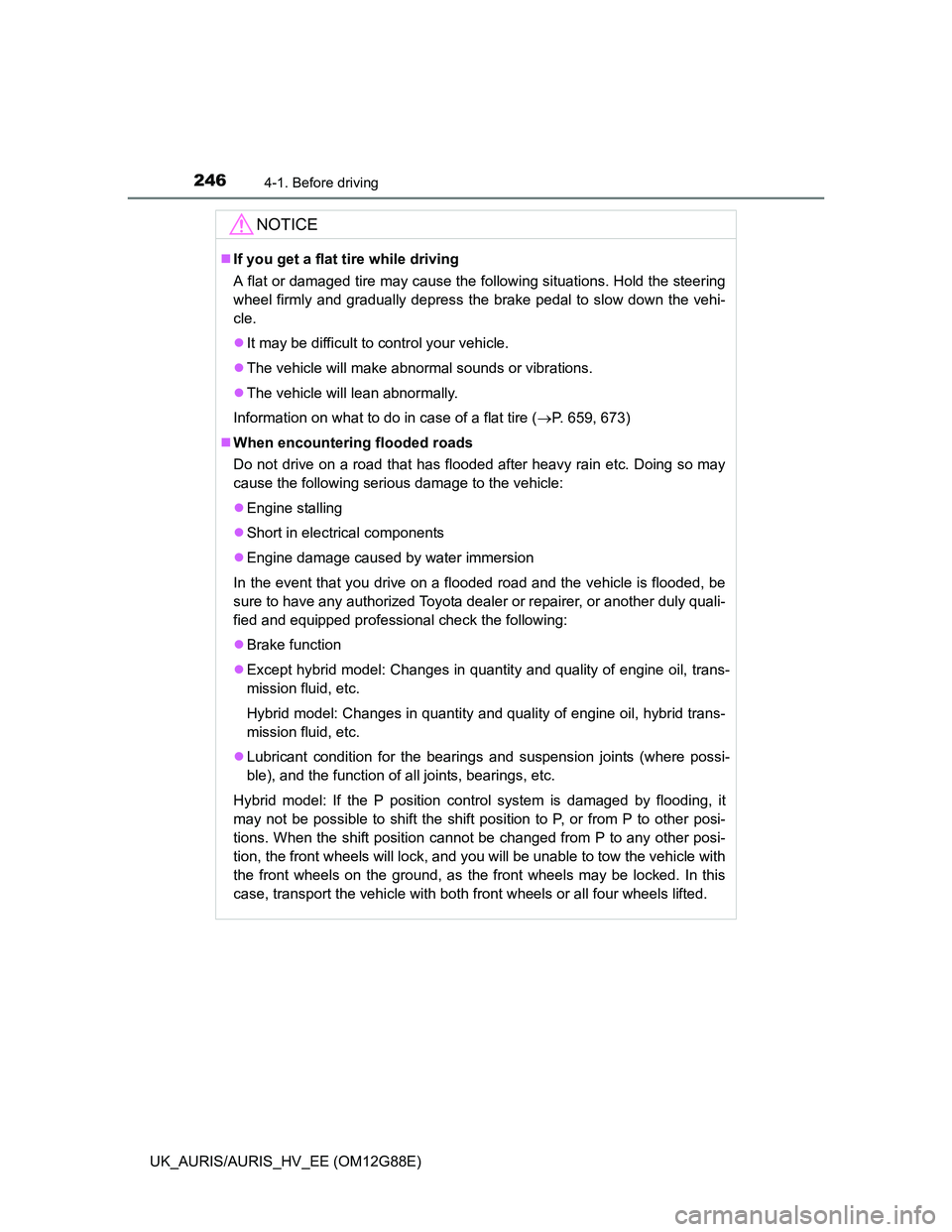
2464-1. Before driving
UK_AURIS/AURIS_HV_EE (OM12G88E)
NOTICE
If you get a flat tire while driving
A flat or damaged tire may cause the following situations. Hold the steering
wheel firmly and gradually depress the brake pedal to slow down the vehi-
cle.
It may be difficult to control your vehicle.
The vehicle will make abnormal sounds or vibrations.
The vehicle will lean abnormally.
Information on what to do in case of a flat tire (P. 659, 673)
When encountering flooded roads
Do not drive on a road that has flooded after heavy rain etc. Doing so may
cause the following serious damage to the vehicle:
Engine stalling
Short in electrical components
Engine damage caused by water immersion
In the event that you drive on a flooded road and the vehicle is flooded, be
sure to have any authorized Toyota dealer or repairer, or another duly quali-
fied and equipped professional check the following:
Brake function
Except hybrid model: Changes in quantity and quality of engine oil, trans-
mission fluid, etc.
Hybrid model: Changes in quantity and quality of engine oil, hybrid trans-
mission fluid, etc.
Lubricant condition for the bearings and suspension joints (where possi-
ble), and the function of all joints, bearings, etc.
Hybrid model: If the P position control system is damaged by flooding, it
may not be possible to shift the shift position to P, or from P to other posi-
tions. When the shift position cannot be changed from P to any other posi-
tion, the front wheels will lock, and you will be unable to tow the vehicle with
the front wheels on the ground, as the front wheels may be locked. In this
case, transport the vehicle with both front wheels or all four wheels lifted.
Page 247 of 788
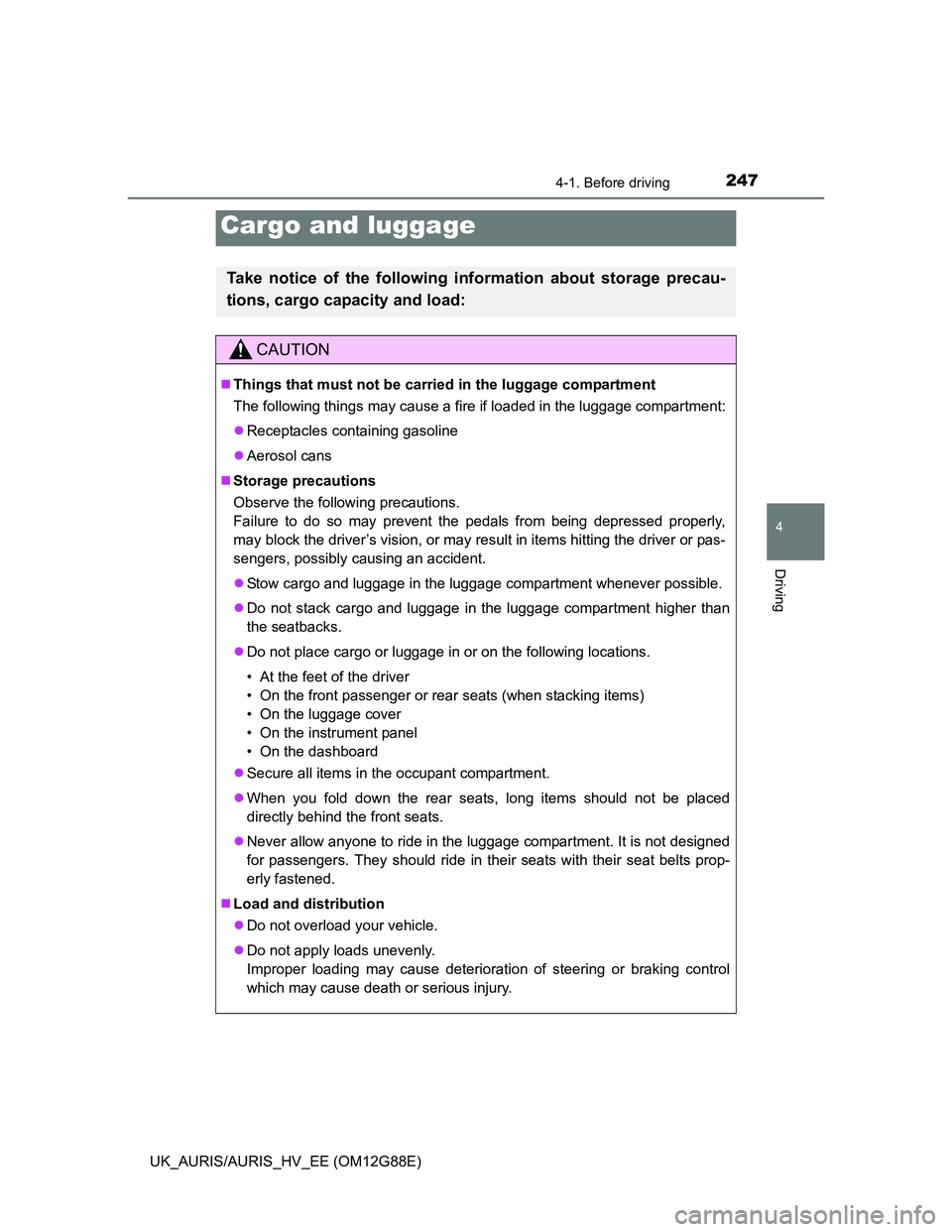
2474-1. Before driving
UK_AURIS/AURIS_HV_EE (OM12G88E)
4
Driving
Cargo and luggage
Take notice of the following information about storage precau-
tions, cargo capacity and load:
CAUTION
Things that must not be carried in the luggage compartment
The following things may cause a fire if loaded in the luggage compartment:
Receptacles containing gasoline
Aerosol cans
Storage precautions
Observe the following precautions.
Failure to do so may prevent the pedals from being depressed properly,
may block the driver’s vision, or may result in items hitting the driver or pas-
sengers, possibly causing an accident.
Stow cargo and luggage in the luggage compartment whenever possible.
Do not stack cargo and luggage in the luggage compartment higher than
the seatbacks.
Do not place cargo or luggage in or on the following locations.
• At the feet of the driver
• On the front passenger or rear seats (when stacking items)
• On the luggage cover
• On the instrument panel
• On the dashboard
Secure all items in the occupant compartment.
When you fold down the rear seats, long items should not be placed
directly behind the front seats.
Never allow anyone to ride in the luggage compartment. It is not designed
for passengers. They should ride in their seats with their seat belts prop-
erly fastened.
Load and distribution
Do not overload your vehicle.
Do not apply loads unevenly.
Improper loading may cause deterioration of steering or braking control
which may cause death or serious injury.
Page 248 of 788
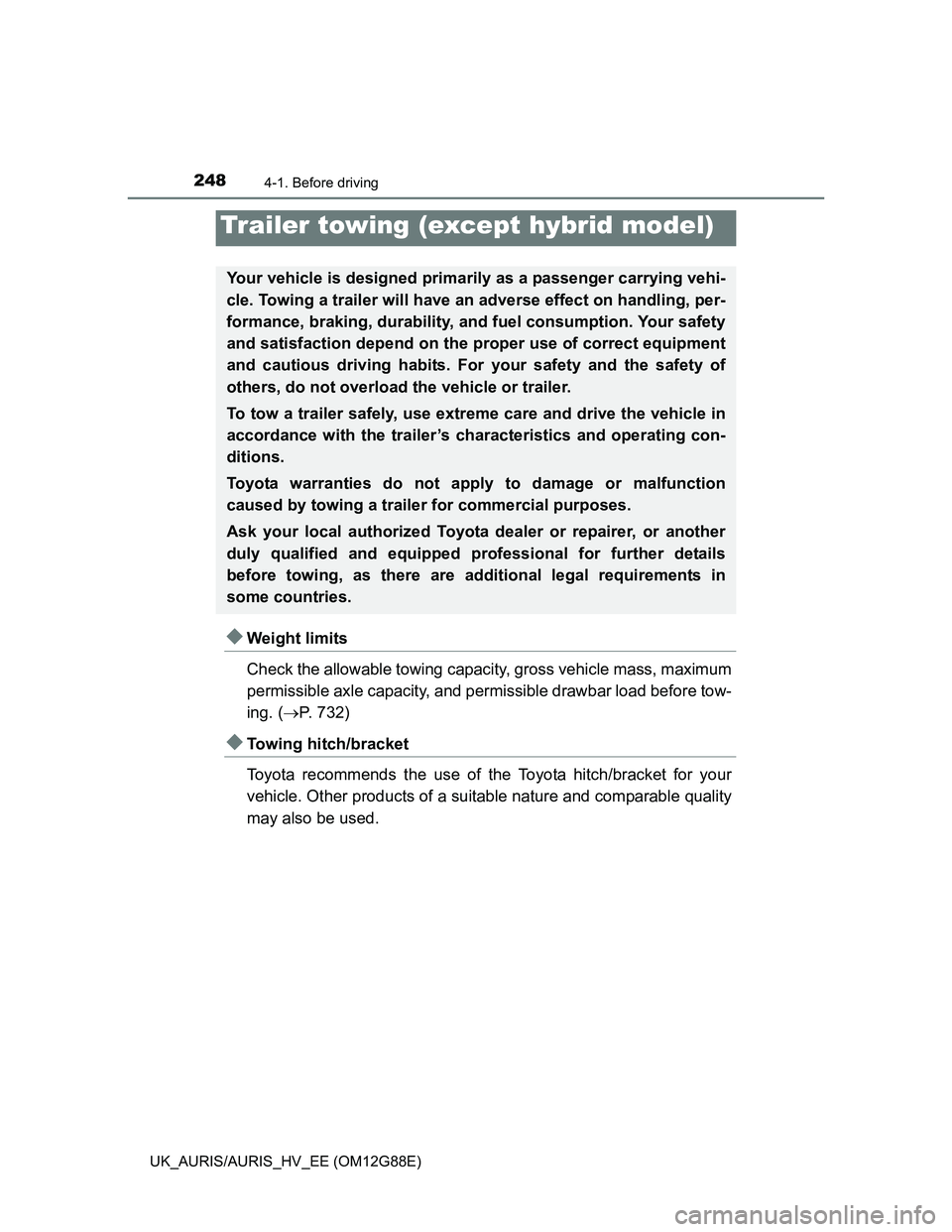
2484-1. Before driving
UK_AURIS/AURIS_HV_EE (OM12G88E)
Weight limits
Check the allowable towing capacity, gross vehicle mass, maximum
permissible axle capacity, and permissible drawbar load before tow-
ing. (P. 732)
Towing hitch/bracket
Toyota recommends the use of the Toyota hitch/bracket for your
vehicle. Other products of a suitable nature and comparable quality
may also be used.
Trailer towing (except hybrid model)
Your vehicle is designed primarily as a passenger carrying vehi-
cle. Towing a trailer will have an adverse effect on handling, per-
formance, braking, durability, and fuel consumption. Your safety
and satisfaction depend on the proper use of correct equipment
and cautious driving habits. For your safety and the safety of
others, do not overload the vehicle or trailer.
To tow a trailer safely, use extreme care and drive the vehicle in
accordance with the trailer’s characteristics and operating con-
ditions.
Toyota warranties do not apply to damage or malfunction
caused by towing a trailer for commercial purposes.
Ask your local authorized Toyota dealer or repairer, or another
duly qualified and equipped professional for further details
before towing, as there are additional legal requirements in
some countries.
Page 249 of 788
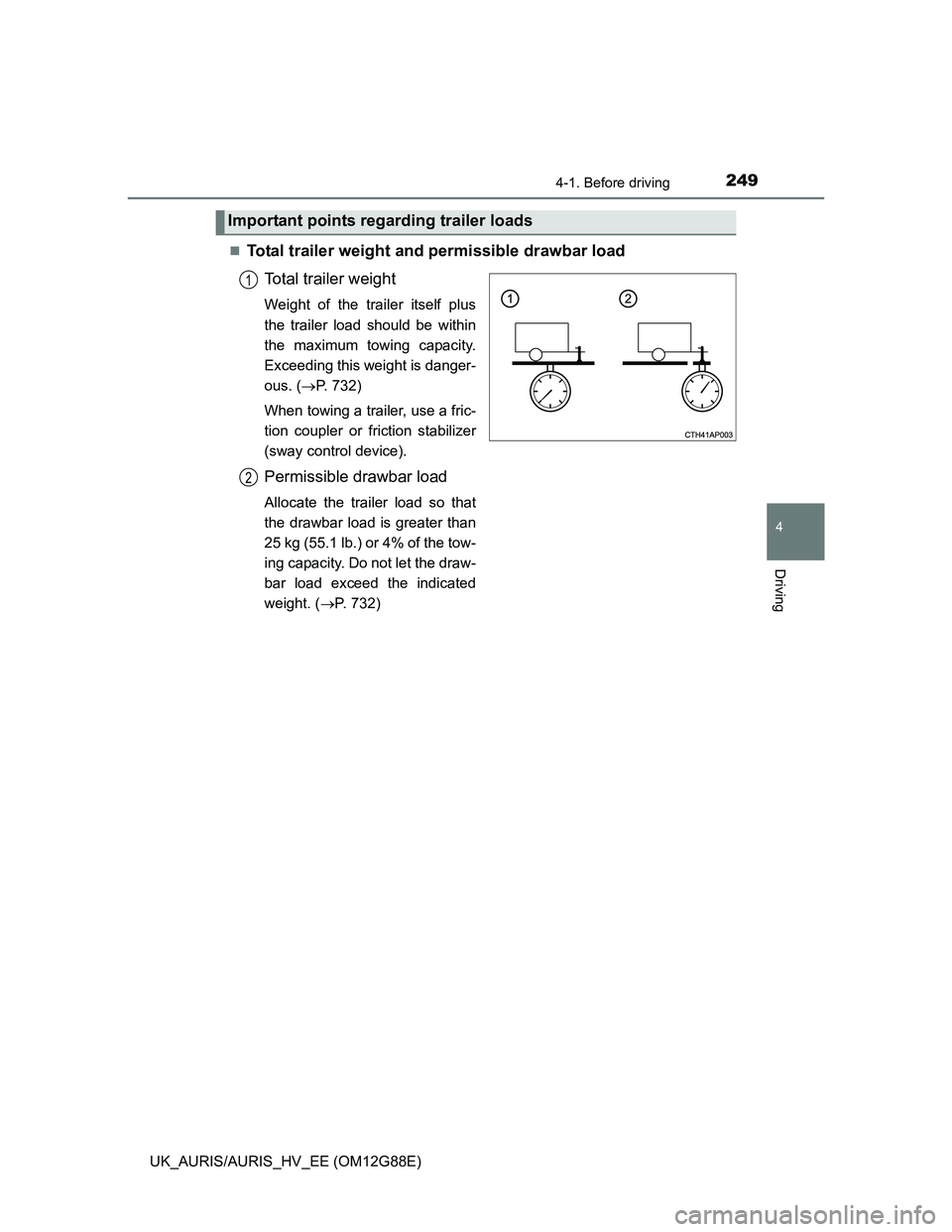
2494-1. Before driving
UK_AURIS/AURIS_HV_EE (OM12G88E)
4
Driving
Total trailer weight and permissible drawbar load
Total trailer weight
Weight of the trailer itself plus
the trailer load should be within
the maximum towing capacity.
Exceeding this weight is danger-
ous. (P. 732)
When towing a trailer, use a fric-
tion coupler or friction stabilizer
(sway control device).
Permissible drawbar load
Allocate the trailer load so that
the drawbar load is greater than
25 kg (55.1 lb.) or 4% of the tow-
ing capacity. Do not let the draw-
bar load exceed the indicated
weight. (P. 732)
Important points regarding trailer loads
1
2
Page 250 of 788
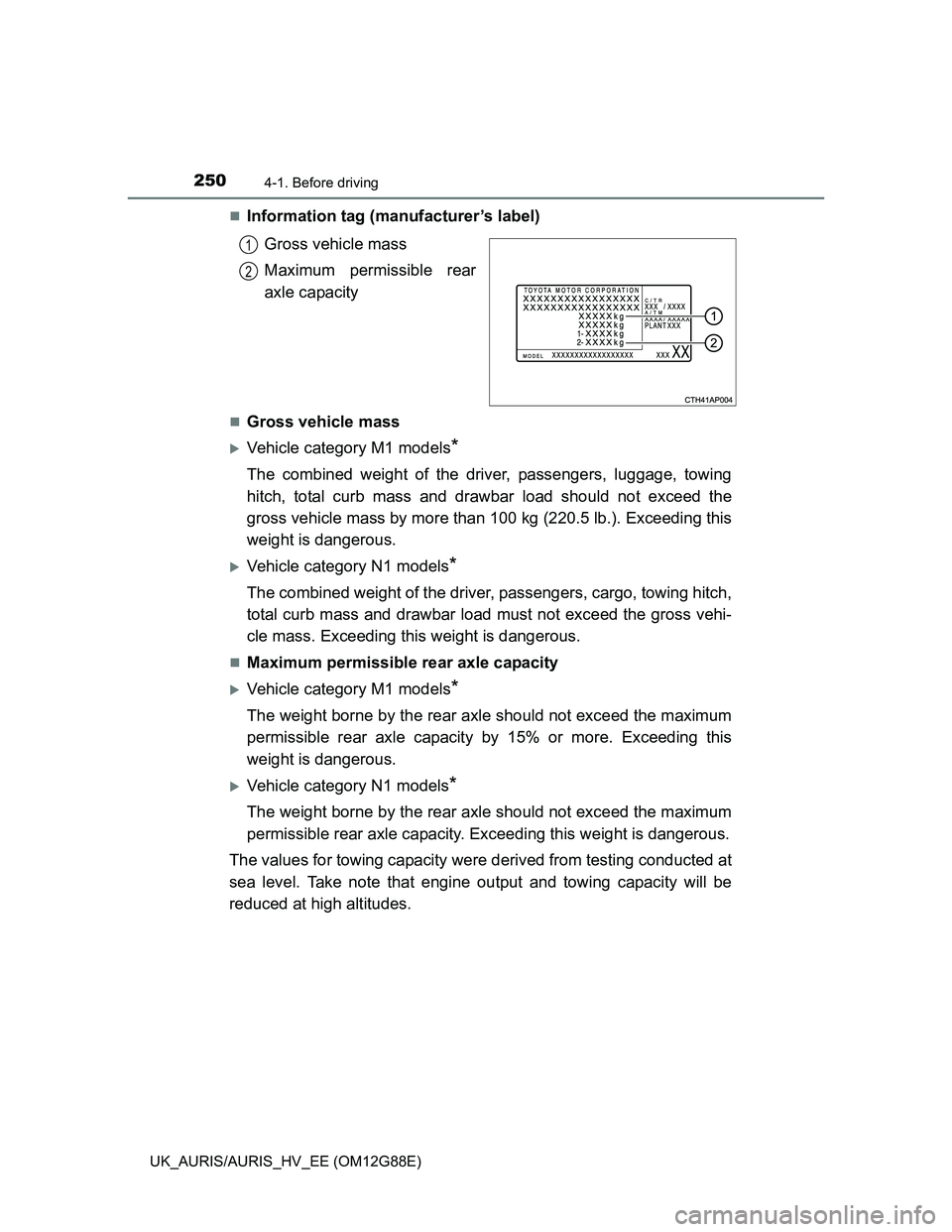
2504-1. Before driving
UK_AURIS/AURIS_HV_EE (OM12G88E)
Information tag (manufacturer’s label)
Gross vehicle mass
Maximum permissible rear
axle capacity
Gross vehicle mass
Vehicle category M1 models*
The combined weight of the driver, passengers, luggage, towing
hitch, total curb mass and drawbar load should not exceed the
gross vehicle mass by more than 100 kg (220.5 lb.). Exceeding this
weight is dangerous.
Vehicle category N1 models*
The combined weight of the driver, passengers, cargo, towing hitch,
total curb mass and drawbar load must not exceed the gross vehi-
cle mass. Exceeding this weight is dangerous.
Maximum permissible rear axle capacity
Vehicle category M1 models*
The weight borne by the rear axle should not exceed the maximum
permissible rear axle capacity by 15% or more. Exceeding this
weight is dangerous.
Vehicle category N1 models*
The weight borne by the rear axle should not exceed the maximum
permissible rear axle capacity. Exceeding this weight is dangerous.
The values for towing capacity were derived from testing conducted at
sea level. Take note that engine output and towing capacity will be
reduced at high altitudes.
1
2